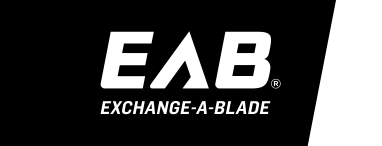EAB Manufacturing Headquarters
Positively mindful of our impact on the environment
The EAB eco central headquarters are located in British Columbia, Canada, where every year tons of used power tool accessories are returned from across North America. Our exchange and recycle systems were introduced back in the 70s, long before the dawning of serious environmental concerns. More than 40 years later, EAB remains firmly committed to playing our part in reducing the impact on our environment—one power tool accessory at a time.
An innovative greener solution founded by EAB
Exchangeable EAB products are returned and either recycled or remanufactured at EAB’s North American manufacturing facility. This ingenious system reduces the need to manufacture new power tool accessories from scratch as well as eliminating the negative environmental effects associated with it.
The EAB green exchange system is a step ahead of just ‘sharpening’ used saw blades—which means lengthy downtimes for you while sharpening takes place. EAB’s green exchange system provides you with a replacement blade when your old blade gets dull and needs to be replaced. Whether your used blade is replaced with a remanufactured blade or a brand new one, the quality will be so good, you’ll never be able to tell the difference.
The EAB ten step green cycle delivers ecological peace of mind
Large shipments of used blades are shipped to EAB every day from across North America. When blades are received they start a rigorous ten step process.
Step 1 |
Each returned item is individually inspected and sorted—blades that meet our high quality standards go to Step 2 for remanufacturing. And those that don’t make the cut, go to our massive recycling bins. |
Step 2 |
Blades are cleaned and buffed to remove labels, wood pitch, and rust. |
Step 3 |
Blades are checked for flatness and any other imperfections. |
Step 4 |
Each carbide tooth is individually inspected. Worn or damaged teeth are replaced. |
Step 5 |
Blades are bead blasted to remove braising marks. |
Step 6 |
Blades are cleaned and polished. |
Step 7 |
Every blade tooth is ground to razor sharpness with fine diamond grit wheels on state-of-the-art, computerized sharpening machines. All blades are completely sharpened on top, sides and face to ensure the best performance. |
Step 8 |
Blades receive final buffing and rust proofing |
Step 9 |
Blades are laser etched, labelled, and ready for testing. |
Step 10 |
Multiple quality control checks throughout the process ensure all remanufactured blades meet or exceed industry specifications. Final quality control is handled by our lab technicians before get their final stamp of approval and ship to the marketplace. All remanufactured blades are restored to their original, or better-than-new quality. |
Recycling smarts
EAB’s eco central is also the permanent home of our recycling depot. Not every returned exchangeable power tool accessory is a candidate for remanufacturing; returned blades that fail EAB’s stringent testing process are recycled along with all other recyclable materials such as non-exchangeable power tool accessories and used display stands. Any and all used metal power tool accessories are accepted by EAB—check with your local retail store to find out if it is a recycling participant. You can rest assured returned recyclable materials will be converted into usable, useful steel products—and not end up in a landfill.
Sustainable production processes and packaging
Most power tool accessories on the market today are made with chromium and are painted. Not so at EAB—to minimize our environmental impact we have eliminated chromium in the production of our products, and we leave them unpainted. Additionally, our preference for bulk and minimal packaging also means you’re not throwing away—and paying for—unnecessary packaging. By design, we seek out innovative, yet safe, packaging for every EAB product to minimize negative environmental impacts.
Help us help the environment
By participating in the EAB green exchange system, you help keep thousands of tons of scrap metal out of landfills, reducing the need to produce new products and the negative effects of this process. You can make a difference.




